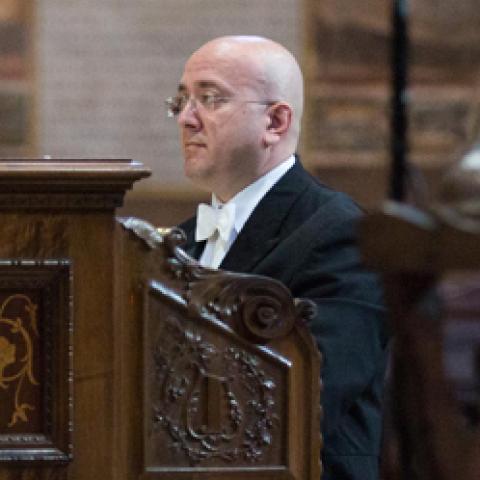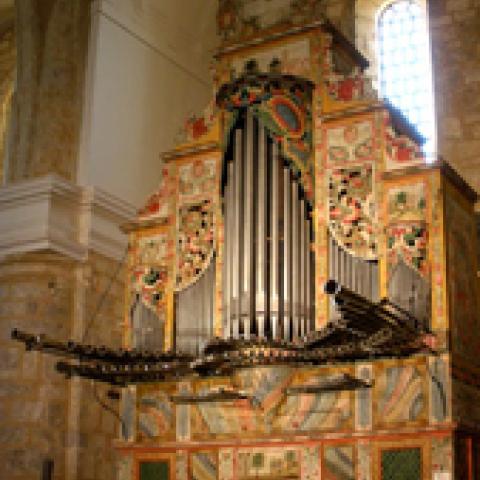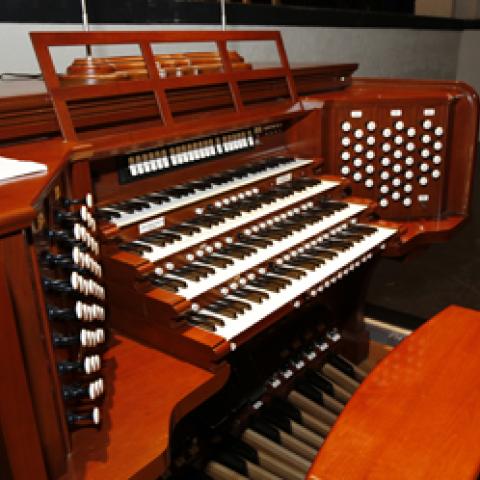It was my great pleasure to play a recital on a historic organ during the sixth international historic organs festival in the Biella area in northwestern Italy. Biella is a lovely town of 50,000, located about ninety minutes’ drive north of Milan and Turin, midway between them. The district’s prosperity comes from production of wool and rice; driving through the area, one spots frequent signs announcing woolen clothing for sale, and rice—including Carnaroli, an excellent rice for making the creamy dish risotto, Italian comfort food at its best.
A younger sister of the “Festival Internazionale Storici Organi della Valsesia” (detailed by Sarah Mahler Hughes in The Diapason, February, 2003, pp. 18–19), the Biella festival is also smaller in scope. Last year’s festival comprised nine recitals in as many Piedmontese towns, with organists hailing from the Czech Republic, Finland, France, Germany, Italy, Slovenia, Spain, and the United States. Both festivals were established by Mario Duella, an amazingly energetic organist and impresario who deserves tremendous credit for establishing a concert series that would do any big city proud, let alone a smaller, less urban area. Through the cultural association he founded for the historic organs of Piedmont, he has organized the restoration and maintenance of numerous organs of the Biella and Valsesia regions, and planned and promoted the festivals so that these musical treasures continue to be heard. (There have also been recordings released of the Valsesia organs, including some festival performances.) The festivals receive support from their respective provinces through local government and churches, as well as local businesses. These provinces have a great musical heritage, and their care and nurturing of it does them proud. (The web site address of the Associazione Culturale Storici Organi del Piemonte is http://utenti.lycos.it/storiciorgani/.)
The Biella festival was established to promote the heritage of historic organs and was designed along the lines of the Valsesia festival. According to Mario Duella, its main focus is to publicize and “make known organs which otherwise would not be appreciated: one only has to remember how little these instruments are used in Catholic liturgy, and think of those organists who are unpaid—or paid little.” Duella notes that in Italy the church organist is a very secondary figure and not always appreciated. (And certainly, the same trend is advancing on this side of the Atlantic.) The ten organs in this year’s Biella festival range in age from 1821 to 1929. All but two were built in the nineteenth century, and all but four are single-manual instruments with pulldown pedal (usually 17 pedals). Several were restored by the Krengli firm of Novara; other restorations were carried out by Mascioni, Giuseppe Marzi, Pietro Contenti, Brondino-Vegezzi Bossi, and Italo Marzi & Figli. The oldest restoration was in Rosazza, restored by Marzi in 1963, the most recent in Vigliano, restored by Brondino in 2002.
The concert schedule of the 2003 festival is listed below:
July 26, Chiesa di Santa Maria Assunta, Salussola
Sergio de Pieri (Australia), with Raffaella Benori (Italy), soprano; instrument: Amedeo e Giovanni Ramasco, 1858, op. 64, I/26, pulldown pedal, restored by Mascioni, 1979
July 31, Chiesa di San Lorenzo, Sostegno
Juan Paradell-Solé (Spain); instrument: Amedeo e Giovanni Ramasco, 1846, op. 37, I/25, pulldown pedal
August 14, Chiesa dei Santissimi Pietro e Giorgio, Rosazza
Matti Hannula (Finland), and Mario Duella (Italy); instrument: Guglielmo Bianchi, 1880, op. 65, I/24
August 16, Chiesa di San Sebastiano, Trivero/Bulliana
Michel Colin (France); instrument: Camillo Guglielmo Bianchi, 1876, op. 52, I/19 September 5, Chiesa di Santa Maria della Pace, Pralungo
Joyce Robinson (U.S.A.); instrument: Luigi Berutti, 1929, restored by Krengli, 1996, II/21
September 6, Chiesa di San Giorgio, Coggiola
Jaroslav Tuma (Czech Republic); instrument: Giuseppe Lingua, 1893, restored by Pietro Contenti, 1990, II/29
September 16, Chiesa di San Giuseppe Operaio, Vigliano
Renata Bauer (Slovenia); instrument: Fratelli Aletti, 1929, restored by Brondino-Vegezzi Bossi, 2002, III/22
September 21, Chiesa di San Michele Arcangelo, Cavaglià
Elmar Jahn (Germany); instrument: Fratelli Serassi, 1821, op. 381, restored by Italo Marzi & Figli, 1999, II/43
September 27, Chiesa dell’Immacolata Concezione, Portula
Sergio Militello (Italy); instruments: Camillo Guglielmo Bianchi, 1885, op. 79, restored by Krengli, 1983, I/11; Giacomo Vegezzi Bossi, 1867, restored by Krengli, 1985, I/27
The organ on which I played was in the church of Santa Maria della Pace in Pralungo, a small suburb of Biella. A two-manual Luigi Berutti instrument from 1929, it had been restored by the Krengli firm in 1996.
Grand’organo
Principale 16’
Principale 8’
Dolce 8’
Ottava 4’
Decimaquinta
Ripieno
Flauto 8’
Unda maris 8’
Tromba 8’
Organo espressivo
Violoncello 8’
Gamba 8’
Violini 8’
Celeste 8’
Bordone 8’
Flauto 4’
Clarino 8’
Oboe 8’
Corale 8’
Pedale
Subbasso 16’
Cello 8’
Ottava 4’
My personal experience playing in the 2003 festival was delightful. My husband and I flew from Chicago’s O’Hare Airport to Rome, where we spent some days with Roman friends; we then took a train to Milan, rented a car, and drove from Milan to Biella, where we had lunch in a small local trattoria, and asked about a public phone so that we could contact our host, Mario Duella. The waiter replied that the phone line was not working. So I worked up a bit of courage to ask the businessmen at the next table if they would accept a few Euros and place a call for me on a cell phone. About six (beautifully tailored) arms reached toward me, offering their cell phones! Mario made arrangements for a practice session in the afternoon. The custodian and parish priest met us and briefly showed us around. The church, built in the early sixteenth century, is not large but makes up for it with beautiful furnishings, statues, and paintings.
The two-manual Berutti organ had a lovely sound and was enhanced by the church’s lively acoustic. The principals, typical of Italian organs, were not strong, but the strings had a definite presence. The flutes and the oboe were also lovely, the tromba fairly powerful. The pneumatic transmission meant the response wasn’t the fastest, so I had to plan my strategy for the repeated notes of Lefébure-Wély’s Bolero de Concert.
Following practice, we were invited to the home of the organist, Prof. Pierangelo Ramella, who lived just a few doors away. His charming wife offered us an aperitivo and we had an enjoyable, if somewhat unbalanced, conversation (my husband does not speak Italian, and our hosts’ young grandson was very shy). The organist, a retired schoolteacher, was also quite the opera fan. He showed us his collection of opera scores (full scores!). Afterwards, he led the way to our B&B, a few small towns away. We thanked him for his kindness and said we’d see him domain.
Our B&B was a huge old building, with our room on the second floor. We chatted with the daughter of the owner (Signora Clara Castelli, who’s on the board of the Fondazione that presents the organ festival) and met one of her dogs. The view from our room was refreshing and inspiring, overlooking a valley and with the Alps in the distance. But the area was hard hit by the summer’s drought. Normally there is plenty of water from mountain run-off, but the great and enduring heat plus lack of rain took their toll. So no running water was available between 9 pm–7 am, and 2 pm–6 pm. Another strategy to plan!
Upon returning to the church the next morning for more practice, we found Don Ezio Zanotti, the charming and simpatico parish priest, there to greet us. In the afternoon, technicians from the Krengli firm came from Novara to tune the reeds (which didn’t sound bad, I thought)—and, I hope, fix the cipher (which did—it was in the pedal, on the principal!). While they worked, I had a lovely conversation with the custodian and Don Ezio while my husband went off in search of gelato.
Later we returned to our B&B to rest. Mario Duella and his lovely wife Franca picked us up at 8 pm and drove us to the church. I set things up in the balcony and reviewed with Mario the pieces for which he would turn pages. Before I knew it, I was sitting in the sacristy, waiting to be introduced. After Mario’s introduction, I walked down the aisle and ascended to the balcony.
My program was eclectic, beginning with Herbert Sumsion’s Ceremonial March, and ending with Dubois’s Toccata in G. In between was an international mélange of works, from the well-known (Bach’s Jig Fugue) to the lesser-known (Licinio Refice’s Berceuse) to the unknown (a transcription of the sinfonia to Pasquale Anfossi’s oratorio La Betulia liberata). I put my Italian to good use and gave a short introduction to each piece.
The audience was most gracious and following the program there were a few short speeches and a gift of local sweets from an excellent pasticceria. And yet another surprise—Mario mentioned that the previous day was our 15th wedding anniversary, so my husband was called to the front, and we were presented with an enormous bouquet of roses and baby’s breath (apparently Don Ezio was behind this!). We were just flabbergasted. Impromptu speeches are not my strong point, let alone in another language, so I hardly knew what to say, but tried to express our deep gratitude.
We then mingled with the departing audience members—one gentleman came up to me, thanked me profusely, and kissed my hand! I greeted as many people as possible, then Mario and Franca whisked us away to a local restaurant for a lovely meal (and some wine!). Mario and Franca drove us home to our B&B, and then it was off to bed, to sleep but very lightly while my brain remained in high gear.
Train ticket to Milan: $70. New organ shoes: $45. Chance to play in this festival: Priceless.
For information on the 2004 Festival, contact: [email protected].






